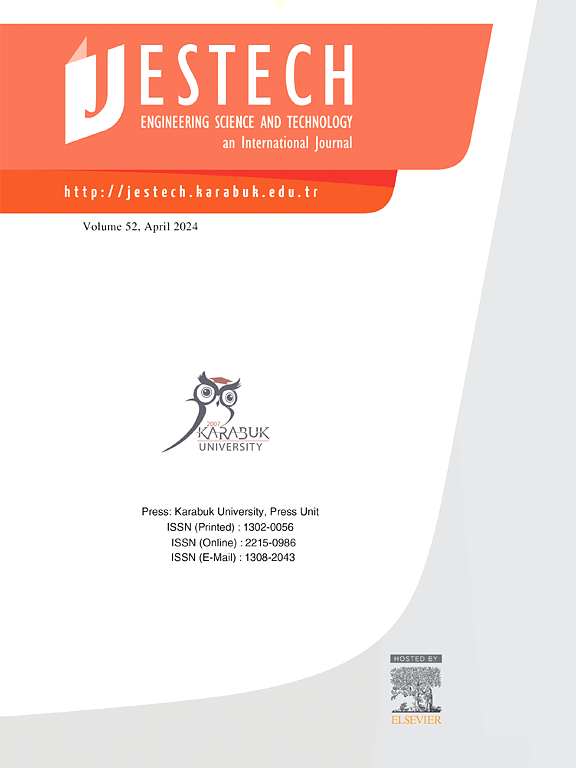An analytical model for thermal and mechanical analysis of solid rotor induction motors
IF 5.1
2区 工程技术
Q1 ENGINEERING, MULTIDISCIPLINARY
Engineering Science and Technology-An International Journal-Jestech
Pub Date : 2025-02-12
DOI:10.1016/j.jestch.2025.102000
引用次数: 0
Abstract
A two-dimensional simplified model of a solid rotor induction motors has been proposed for the analysis of the coupled electrical-thermal–mechanical behaviour of the rotor at steady state. Rotor is assumed to be an infinite cylinder, and the stator is assumed to have infinite magnetic permeability. The electrical model of the motor depends on the definition of the slip to which all the results are referred. This makes all the field variables functions of the radial coordinate only. Eddy currents, temperature field, and elastic displacement field within the rotor are solved analytically. Eddy current computations were compared with finite element solutions. Temperature and displacement fields as a function of slip have been presented. The proposed model has the distinction of being largely analytical, and it gives good estimates for the temperatures, and stress and displacement distributions within the rotor, therefore making critical predictions concerning mechanical integrity of the design, such as verifying that the rotor will not rub on the stator due to displacements as a result of both thermal and mechanical stresses.

固体转子感应电动机热力学分析的解析模型
建立了固体转子异步电动机的二维简化模型,用于分析转子稳态电-热-力耦合特性。假设转子为无限大圆柱体,定子为无限大磁导率。电动机的电气模型取决于所有结果所参照的滑移的定义。这使得所有的场变量仅为径向坐标的函数。对转子内部的涡流、温度场和弹性位移场进行了解析求解。涡流计算与有限元解进行了比较。给出了温度场和位移场作为滑移的函数。所提出的模型具有很大程度上是分析的区别,它给出了很好的估计温度,以及转子内的应力和位移分布,因此对设计的机械完整性做出关键预测,例如验证转子不会摩擦定子由于热和机械应力的位移。
本文章由计算机程序翻译,如有差异,请以英文原文为准。
求助全文
约1分钟内获得全文
求助全文
来源期刊

Engineering Science and Technology-An International Journal-Jestech
Materials Science-Electronic, Optical and Magnetic Materials
CiteScore
11.20
自引率
3.50%
发文量
153
审稿时长
22 days
期刊介绍:
Engineering Science and Technology, an International Journal (JESTECH) (formerly Technology), a peer-reviewed quarterly engineering journal, publishes both theoretical and experimental high quality papers of permanent interest, not previously published in journals, in the field of engineering and applied science which aims to promote the theory and practice of technology and engineering. In addition to peer-reviewed original research papers, the Editorial Board welcomes original research reports, state-of-the-art reviews and communications in the broadly defined field of engineering science and technology.
The scope of JESTECH includes a wide spectrum of subjects including:
-Electrical/Electronics and Computer Engineering (Biomedical Engineering and Instrumentation; Coding, Cryptography, and Information Protection; Communications, Networks, Mobile Computing and Distributed Systems; Compilers and Operating Systems; Computer Architecture, Parallel Processing, and Dependability; Computer Vision and Robotics; Control Theory; Electromagnetic Waves, Microwave Techniques and Antennas; Embedded Systems; Integrated Circuits, VLSI Design, Testing, and CAD; Microelectromechanical Systems; Microelectronics, and Electronic Devices and Circuits; Power, Energy and Energy Conversion Systems; Signal, Image, and Speech Processing)
-Mechanical and Civil Engineering (Automotive Technologies; Biomechanics; Construction Materials; Design and Manufacturing; Dynamics and Control; Energy Generation, Utilization, Conversion, and Storage; Fluid Mechanics and Hydraulics; Heat and Mass Transfer; Micro-Nano Sciences; Renewable and Sustainable Energy Technologies; Robotics and Mechatronics; Solid Mechanics and Structure; Thermal Sciences)
-Metallurgical and Materials Engineering (Advanced Materials Science; Biomaterials; Ceramic and Inorgnanic Materials; Electronic-Magnetic Materials; Energy and Environment; Materials Characterizastion; Metallurgy; Polymers and Nanocomposites)
 求助内容:
求助内容: 应助结果提醒方式:
应助结果提醒方式:


